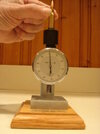CQB45ACP
Member
It's good to teach & learn multiple methods. Thanks for providing yours.Which is fine...but not relevant to using a tool to measure what you have. You're using exceptions to justify not measuring to validate a published specification. Like I said, you do you. Measure, don't measure...whatever works for you. What I'm trying to do is demonstrate to new users, or to people that are having challenges with certain types of primers...a method to check depth when they think it's seated deep enough based on feel, when in fact it is not. This was a post to demonstrate one method of measuring primer seating depth in a definable and useful way for folks who may not know how to, or that they in fact already have the tool to do it.
Again, to emphasize, regardless of all the noise here...if you cannot measure a minimum of a .003 primer depth, then your primers are not seated deep enough. Square pocket, round pocket, blue pocket, the number of molecules on a pin head...whatever argument you want to make...doesn't matter.
Btw, you hyper sensitive touch guys....You realize people aren't born reading brail right? They have to be taught the meaning of what they feel...which is why telling people how great your sensitivity is...ain't real helpful to the guy trying to figure out the problem with his reloads.
But, for those of us who only took one shop class in high school 60 years ago and then learned everything else scraping our knuckles on our cars, saying "just take your calipers and do this" isn't all that simple. (Gee, thanks, if I was as coordinated as you and didn't have arthritis, that's what I'd do.)
But, I also completely agree, telling someone new to this or that to "feel" when something is right or wrong, is like a foreign language.
But, they're both valuable and mutually supporting.
Our brains are amazing things and some of us can develop the "feel" of something long before we can master the physical manipulation of a tool to the necessary level of precision.
As my post #4 indicates, I tried the caliper method with apparent success, but I'm telling you it wasn't all that easy.
Long (years) before that however, I had developed an eye and feel for a good workable example, memorized it, and could spot a bad example a mile away. No, I wouldn't be able to provide numerical measurements, but I'd just know.
Now, I can do both.



 )
)